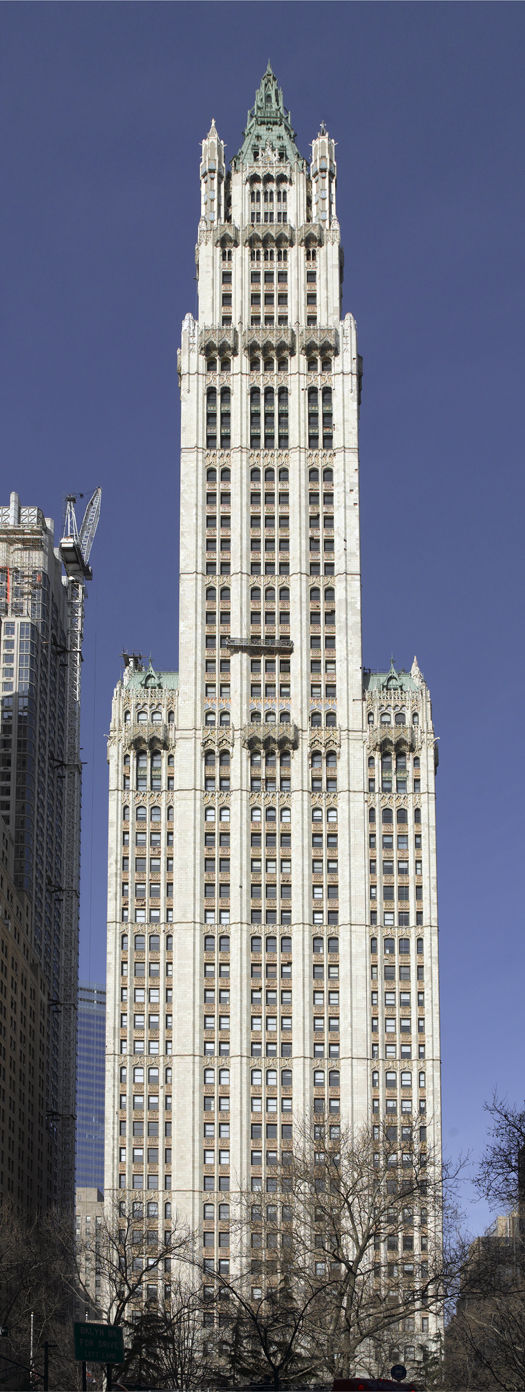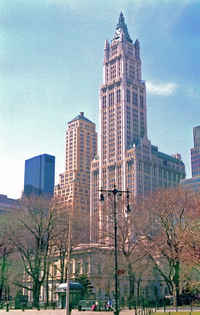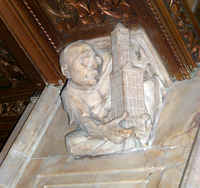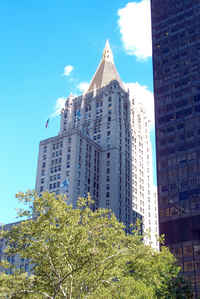
Woolworth Building, 2007, Carol Highsmith
Woolworth Building
- Location:
- 233 Broadway, New York, New York
- Design & Construction:
- 1910-1913[1910-1913 Irish-1999; 1910-1913 Christen-2001]
- Architect:
- Cass Gilbert
The Woolworth Building is Cass Gilbert's best-known tall building and one of the most famous skyscrapers in the United States. When it was completed in 1913, it was the tallest building in the world and a potent symbol of the F. W. Woolworth Company. The 60-story tower with its terra-cotta cladding and neo-Gothic ornament helped to transform the skyline of New York. At the grand opening on April 24, 1913, President Woodrow Wilson pressed a button to signal the lighting of the structure, and the Rev. S. Parkes Cadman dubbed it the "Cathedral of Commerce." [Much of this account is derived from NYC-Landmarks-1983a.]
Frank W. Woolworth had opened his first five and ten cent store in Lancaster, Pennsylvania, in 1879. His retailing concept quickly achieved success, and he began to add more stores, expanding throughout the East Coast and in the Midwest. In 1910 he merged his company with those of four competitors to create the F.W. Woolworth Company, a corporation controlling 611 stores. That same year he began to plan a new corporate headquarters on a site at the corner of Broadway and Park Place, facing City Hall Park, and hired Cass Gilbert as architect.
Early in the project, Woolworth was interested in building an office building that would surpass neighboring buildings in height. He was then struck with the idea of surpassing the 612-foot height of the Singer Building, designed by Ernest Flagg and completed in 1907, and the 700-foot height of the Metropolitan Life Insurance tower, designed by Pierre LeBrun of Napoleon LeBrun and Sons and completed in 1909. He instructed Gilbert to prepare plans for an even higher tower, ultimately 792 feet.
Both Gilbert and Woolworth wanted a beautiful building. At the same time, Gilbert had to make the world’s tallest building practical and economic as an office building. The structural steel frame was clad in architectural terra cotta from the Atlantic Terra Cotta Company. Most of the terra cotta was light cream in color with polychromatic ornament that accentuated the Gothic detail. Gilbert worked with structural engineer Gunvald Aus on the foundations, which required sinking 69 pneumatic caissons to bedrock 100 to 120 feet below grade. [Irish-1999 p. 128]
The ground-floor lobby is a dramatic vaulted space with mosaic-covered ceilings. A grand staircase at the west end of the lobby leads up to what was originally the headquarters for the Irving National Bank. Sculpted figures on the ceiling beams inside the entrance caricature Woolworth, Gilbert, and other major figures involved in the design and construction of the building.
The Woolworth Building was the last major skyscraper constructed in New York before World War I. Its romantic tower form helped to establish the prototype for a group of skyscrapers built in the 1930s.
The building remained the headquarters of the Woolworth Company until the company went out of business. It was subsequently sold to a New York real estate development group that intended to convert part of it to a residential condominium. Due to economic conditions, this has not happened. Most of the building remains in use as offices.
See Also
-
Gail Fenske. The Skyscraper and the City: The Woolworth Building and the Making of Modern New York (Chicago: University of Chicago Press, 2008). This expands and refines the content and analysis of Fenske’s Ph.D. dissertation.



